After years of use, gas fireplaces often develop a cloudy white haze on the glass. This white haze makes the flames difficult to see, ruins any potential illusion that you’re looking at a real fireplace, and really kills the mood. Ok, maybe that’s a little dramatic, but it is annoying.
 The good news is that you might be able to clean this off. To clean the white haze off of your gas fireplace glass, you can start by purchasing a product that’s made specifically for this, such as White Off. I picked some up at the Minnetonka Fireside Hearth & Home store for about $8. It’s a small bottle, but for how often you’ll use this stuff, it’s a lifetime supply.
The good news is that you might be able to clean this off. To clean the white haze off of your gas fireplace glass, you can start by purchasing a product that’s made specifically for this, such as White Off. I picked some up at the Minnetonka Fireside Hearth & Home store for about $8. It’s a small bottle, but for how often you’ll use this stuff, it’s a lifetime supply.
The next step is to remove the glass on your gas fireplace. This is probably the most difficult part, and every gas fireplace is different, so I can’t offer much advice here. You can try looking up instructions online by searching with your model number – just pop open the bottom access panel, clear away some of the dust, and you should be able to locate the model number. You’ll obviously want to turn the gas off to your fireplace first, and allow the glass to cool down before removing it, if necessary.
After you have removed the glass, place it on a flat surface, such as the floor or a table. You might want to lay down a towel underneath for good measure, but I chose to live life on the edge while cleaning mine.
Next, follow the directions on the bottle; shake well, apply liberally, clean with paper towel, etc… repeat as necessary.
Once you’re done, the glass should look much better and all of the white stuff should be gone. If the glass still looks dirty once you’re done with this step, there’s probably no cure. Have you ever noticed how the glass on your gas fireplace will get a bunch of condensation on it when the pilot is lit after having been turned off?
This is happening because the warm, moist combustion gases are coming in contact with the relatively cool glass. As soon as the glass warms up, the condensate disappears… but over time, this repeated exposure to condensation can be enough to permanently etch the glass. Once this happens, the only repair is to have the glass replaced. Replacement glass panels for gas fireplaces range from $200 – $400, according to Ken at Glowhearth.
Reuben Saltzman, Structure Tech Home Inspections

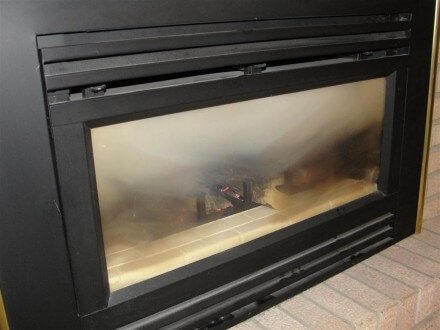
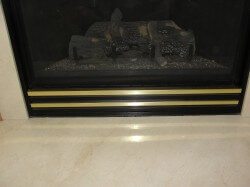
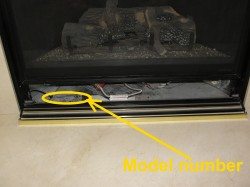
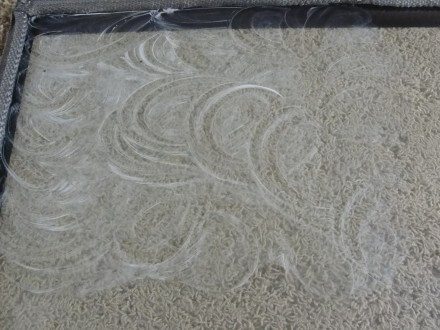
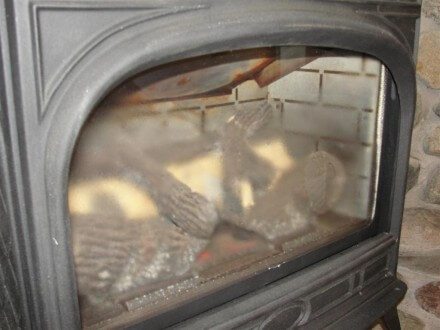
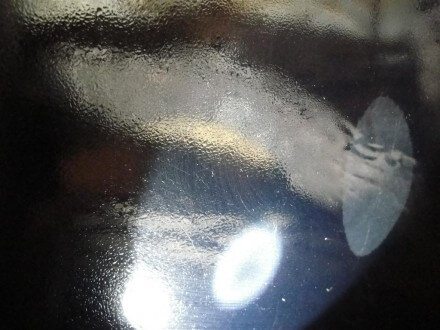




Jim Allhiser
July 3, 2012, 5:39 am
Reuben,
There is a fix for that as well as etched shower door glass. At automotive supply stores they sell burnishing paste. You can actually buff a new surface into etched glass.
I have also heard that the white deposits are from the sulfur smell that is added to the gas to make it detectable. Pure natural gas burns very clean.
Reuben Saltzman
July 5, 2012, 7:37 pm
Jim – have you tried the ‘buff’ method? I might have to give that a try myself.
Craig – thanks for the info.
Craig Morris
July 5, 2012, 5:34 pm
This white haze occurs equally with natural gas or propane. I’ve been told it is from the off gasing of the RTV silicone,sealants and ceramic fiber components used in the manufacturing process of the fireplace. This makes sense…the haze occurs most noticeably in the first one or two years of use and decreases quite a bit ( down to almost zero) after a few years of use. It comes off easily when cleaned as necessary in these first couple years. If left to bake on for several seasons with no clean up, it becomes un removable and glass replacement is the only option.
June
December 23, 2012, 4:03 pm
We just purchased a house with gas fireplace in basement .. Purchased in 1990
We used it twice for a short time and didnt smell anything
The glass in the door was worn badly so a local glass shop put in a new piece of corning glass… Now there is a burning smell about five minutes after lighting
Gas man checked and said no leaks
Why would new glass smell or is it coincidence… Burns our eyes too even after cracking open a window
Thanks
Reuben Saltzman
December 24, 2012, 5:40 am
Hi June,
I don’t know why your gas fireplace is making an odor now; my best guess is that the glass isn’t making a tight seal. You might want to have someone double-check to make sure there is no exhaust gas leaking out. The ‘gas man’ might have made a mistake.
– Reuben
June
December 24, 2012, 8:05 am
Many thanks for the speedy reply and recommendation.
So, if there is a tiny leak of natural gas, that would make a “burning smell”?
I am familiar with the smell of the houswehold gas as used to cook with it many years ago; but this
is definitely a “burning” smell after fire has been on for maybe five to ten minutes.
We wonder if the glass cutters used some type of oil on the edges of the glass to cut, before inserting it back into the brass frame… but they are closed for the Holidays.
We did notice that one of the fake logs has been charred at one point in time, at the end.
It’s unfortunate we have no history of the fireplace, although previous owners did leave one instruction booklet.
We would buy a new one but next on list is new roof!
Thanks again, J.
Reuben Saltzman
December 25, 2012, 6:08 am
Hi June,
My concern is that the fireplace is leaking exhaust gas, not natural gas. Exhaust gas will definitely have a burning smell, and if the glass doesn’t make a proper seal, the exhaust gas will come in to the house.
If you have a charred fake log, there’s a good chance that you also have a combustion problem with your fireplace. You should have an HVAC technician check for exhaust gas leakage at the fireplace, and you should also have them test the exhaust gases to make sure your fireplace is burning properly.
June
December 28, 2012, 8:00 am
… many thanks for the suggestion. Have passed it along to my husband. He retightened the screwes around the glass door and put the carbon monoxide detector closer to the fireplace, and will monitor. If still have problems, will call the technician back……….. June, Ontario
Jason Harrison
April 7, 2013, 10:55 pm
My understanding is that the white haze is from water soluble minerals carried in the natural gas along with water vapour. Think of “natural gas” as a mix of chemicals, some that burn, some that smell (for detecting leaks), and some that come along for the ride.
The moisture on the inside of the glass when you first light it could be from water vapour in the natural gas, water created by combustion, and water vapour accumulated in the cavity from the outside air supply.
Which of these is cool enough to condense quickly when you turn on the gas? Full points for water vapour in the natural gas. Zero points for accumulated water. 🙂